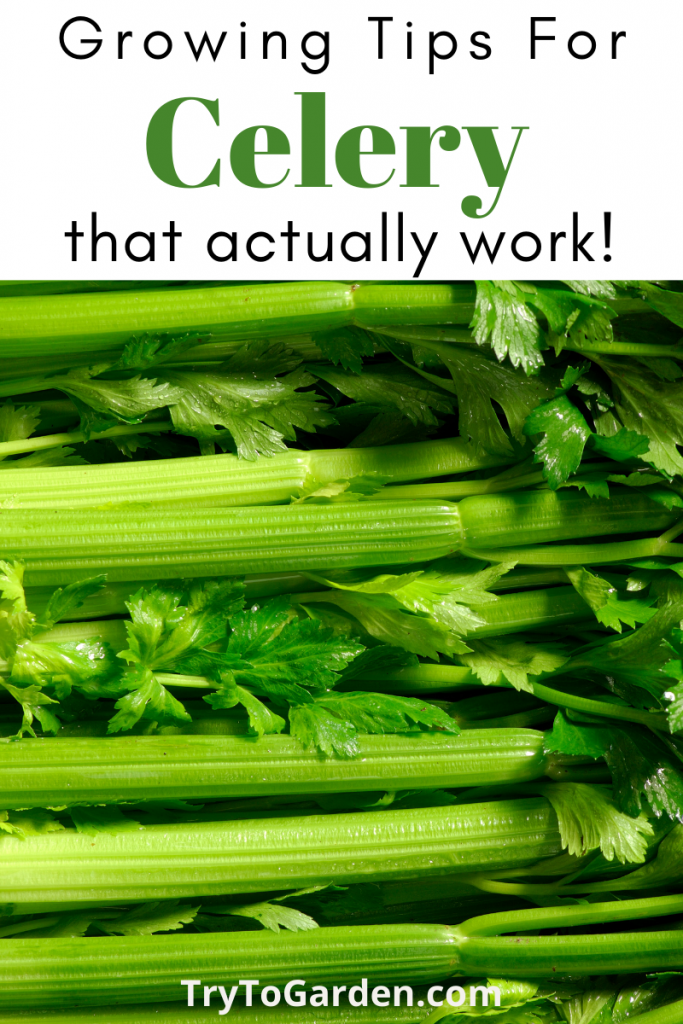This post contains affiliate links, which means I will make a commission at no extra cost to you should you click through and make a purchase. As an Amazon Associate I earn from qualifying purchases.
Check out these growing tips for celery. Learn how to grow more celery and what you need to do for larger bunches.
Celery is considered a low-calorie diet food as it provides only ten calories per stalk. It has a crunchy taste, and celery is known to have loads of nutritional benefits. It has been used in the kitchen to make some beautiful recipes.

Celery, over the years, has been extensively used as a filler food to make meals wholesome. They are usually added to chicken soups with many vegetables to make the dish more appealing and filling.
Gardening Tips for Celery that Actually Work
There is some debate about the history of celery. But there is no denying the fact that almost everybody on the planet loves the vegetable. It has become a household staple along with carrots and onions. It is a biennial vegetable and belongs to the same family of carrots, dill, and fennel.
History of Celery
It is believed that celery originated from the Mediterranean basin and was cultivated for medicinal purposes before 850 B.C. The Romans valued celery more for cooking purposes than religious ones. However, it originated from the Mediterranean region. People found wild varieties of celery in Egypt, South America, California, India, and New Zealand. People in Italy grew celery in the 17th century. Gradually, the cultivation of the vegetable became widespread. However, in North America, people prefer to eat it raw, although the cooked version is equally popular. Today, Celery forms an integral part of gourmet cuisine in the US.

Benefits of Celery
Celery has some surprising health benefits which are worth considering. The vegetable is rich in antioxidants that help to fight cancer in the body. There are enough studies to suggest that eating just two stalks per week can reduce lung cancer chances by as much as 60%. Celery is also highly effective in fighting against breast and ovarian cancer. Extracts of the celery seed have been studied for anti-inflammatory properties, and they have been successfully used to treat inflammation over the years. The celery seed extracts are said to be as effective as aspirin or ibuprofen.
Basic Celery Facts
Celery enjoys a long growing season, and the veggie does take its time to sprout. The germination can take as much as eighteen days. But if you want faster germination, then soak the seeds in warm water overnight.
The celery plant grows well in the cool spring and summer regions, making sense to plant celery in the early spring. If you live in summer regions, you should plant celery in the late summer. Then, you can harvest it in early winter.
Celery cannot tolerate heat and prefers a cool, cloudy region. During the growing season, it expects a temperature range between 60 to 70 degrees F. You should plant celery in an area where the region enjoys at least four months of cool weather.
Celery is a high-yielding vegetable, but the actual yield depends on many factors such as soil type, farm management practices, and climatic conditions. You should get on celery plant per bulb.
Although celery juice is popular, many people are opposed to having celery in the juice form. There are other ways to enjoy this stalky vegetable. One can chop it and use in warm soups, add it to smoothies, slice it for salads or add it to stir-fries. Even raw with dip or peanut butter is a winner.
Gardening Tips for Celery: Soil
Celery prefers soil with a high water retention capacity. Peat soil is the best choice for cultivating celery. But if you are looking for commercial farming, you should opt for rich, well-drained, and deep soils for the purpose. You can grow celery in clay soil too, provided you fulfill the other conditions. However, celery would not grow well if the pH level is more than 5.6, ideally a pH between 5.8 and 6.8.

Planting
If planting by seed, sow celery seeds ¼ to ½ inch deep, 6 to 10 inches (15-25cm) apart; space rows 24 inches (61cm) apart.
You should sow the seeds in a well-prepared bed as they take a long time to germinate. Transplant seedlings started indoors into trenches 3 to 4 inches (7.6-10cm) deep set 6 to 10 inches (15-25cm) apart.
Gardening Tips for Celery: Plant Care
A growing celery plant would need loads of water. Maintaining of the soil is important as it must remain moist at all times, and proper watering is mandatory as the plant cannot tolerate drought. If you don't keep the ground adequately moist, then the celery will taste differently. Also, one needs to fertilize regularly so that the plant gets lots of nutrients.
Harvesting Celery
If you don't need the whole plant, cut stalks as needed. If you cut just the stalks you need, the plant will keep producing new stalks. Harvest individual stalks from the outside in. Cut individual stalks or the whole plant with a serrated knife. This way your plant can keep on growing.
If you choose to, you can cut the entire head off - The plant is cut just a few inches below the surface using a sharp knife.
Enjoying Celery

You can enjoy celery in creative ways, but the most common way to have celery is to add it to chicken soup or chicken salad. You can even have it raw just by dipping it in a salad dressing. It has a mild sweet taste and a crunchy feel.
Finally, learn how to regrow celery inside.
